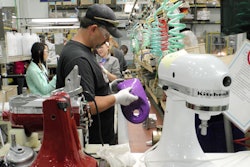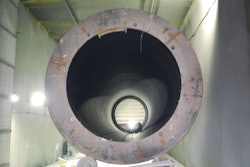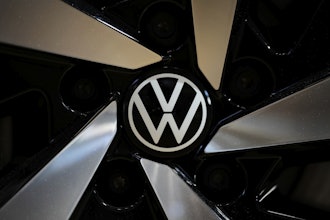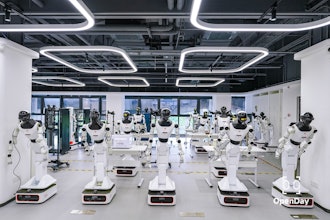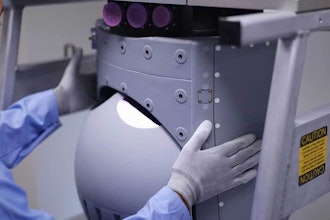Just how big of a priority is energy efficiency? It seems manufacturers are willing to do more than just pay lip service to the idea of a more efficient facility.
This article originally appeared in the July print issue of IMPO.
It seems every year that budgets get tighter and costs get higher — no matter what business you’re in. In manufacturing, where aging equipment is a given and energy rates are a cost center of sometimes epic proportions, it’s no wonder management is looking for more efficient ways to put product out the door.
And yet, there are so many other big priorities to factor into an overall equipment strategy that it begs the question: just how important is energy efficiency to the average manufacturer? Distributed via email, we asked a group of nearly 300 IMPO readers to tell us how much energy efficiency and sustainable products matter to them, and how this affects their purchasing.
Spending on Energy
Sometime in the next six months, 46.5 percent of our survey respondents say they plan to purchase equipment based on its energy efficiency (Figure 1). It’s interesting to review the way manufacturers have answered this question over the past five years: in 2010, 52 percent had said the same, with results growing incrementally and peaking in 2012 (at 62 percent) before beginning to dip again.
It’s possible the spending upticks in 2011 and 2012 had to do with more aggressive post-recession stimulus programs that made it easier for businesses to justify capital spend. Today, a modest pickup in business spending is under way as manufacturing activity strengthens. According to a recent report by Kiplinger’s, capital spending for 2014 is expected to rise by 4.5 to 5 percent. This is a nice bounce upward from the meager 1.5 percent spending increase in 2013, but will trail the 6 percent rise posted in 2012.
“Still, companies remain cautious about dipping into their cash piles, and the uptick in spending will be modest,” said the report. Additionally, “Companies are also wary of adding too much capacity at a time when consumer purchasing power is strained. Wages and salaries have grown too slowly since the recession ended to trigger a surge in investment and spending.”
So even if they don’t have the budgets to spend, for most energy efficiency is still a consideration — though not always their first. A mere 8.2 percent say energy efficiency is the number one priority they consider when purchasing new equipment — approximately the same sized group who say it’s a low or no priority element (Figure 2). The majority of respondents fell into two groups: those who say it’s important, but not above other issues (45.3 percent) and those who say they consider it, but oftentimes it is overshadowed by more pressing concerns (37.1 percent). Interestingly, the size of the group who said it was a low priority increased by 3.6 percentage points.
The Culprits
As usual, most of our respondents said that plant environment products (HVAC, fans, lighting and the like) were the least energy efficient of their existing products. Pneumatic systems took the second slot for energy hogs, followed by motors and drives and fluid handling (Figure 3). For most, the reasons these are so inefficient varies, but many say it’s simply too expensive to swap existing equipment for more efficient models. Others say that it’s the natural quality of the product that makes it inefficient, its age, or that it’s being used in an inefficient way.
For most of our respondents, the types of equipment they plan to invest in for energy efficiency reasons pretty much line up with the types they’ve identified as being problematic currently. For example, 46.5 percent say they plan to invest in plant environment type products, with nearly 41 percent identifying that category as currently the least efficient. More than 30 percent say they have no plans to upgrade any existing equipment at this time (Figure 4). One respondent said they were “looking to upgrade equipment for throughput, but green is not a priority — output is.”
Past, Future, & ROI
Some manufacturers have already been busy upgrading their equipment, and the most cited areas for recent equipment purchases include plant environment products and motors and drives. Of those who've purchased new equipment, most (51.9 percent) say the purchase was based "in part" on its energy efficiency. For many replacing long outdated equipment, energy efficiency gains simply come with the territory of a newer model. Eleven percent said their recent purchases were "wholly" based on the energy efficiency gains the new equipment offered, while 19 percent said this was not a factor at all. As far as expectations for ROI, most require a one to two year payback on their equipment investments, with the second highest group saying they expected a two to four year payback period. These results are fairly consistent with those of years past.
Some also look forward to the opportunity to purchase more environmentally friendly consumable type products. Though these products don't typically yield any energy savings (and, thus, utility cost savings) they do often offer a safe alternative to some harsh chemicals and materials that many manufacturing workers are exposed to daily. When asked "Of the following consumables, which might you
consider purchasing if available in green, organic, or recycled materials?" nearly two-thirds said they'd have an interest in "greener" cleaning supplies. Runners up include towels/wipes, degreasers, and absorbents (Figure 5). Over 7 percent expressed no interest in purchasing green or sustainable consumable products, which is a significant drop from last year, when over 15 percent said the same.
A Perfect World
For many manufacturers, energy efficiency becomes top of mind when there is a specific flaw that's wreaking havoc on their budgets. So like in years past, we try to uncover which areas – in a perfect world – they'd address with more efficient equipment. Solar and wind power were popular amongst these manufacturers, as many likely seek to gain some energy independence to reduce the required need of peak time usage of commercial utilities. Additionally, our readers said:
- Reusable shipping containers.
- On-demand hot water.
- A fuel cell fork lift.
- Equipment that has on-demand (stop-start) technology.
- Energy metering in production equipment.
- Energy recover and cogeneration.
- Steam collection/collection of
- boiler condensate.
Ultimately, equipment is only one part of the overall equation. In a manufacturing environment, operators make all the difference when it comes to effective use of production and plant resources. Said one respondent when asked what his "perfect world" energy saver would be, "More efficient people."
Read Next





